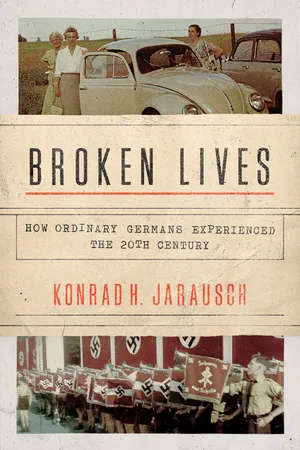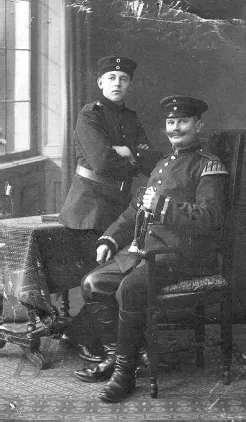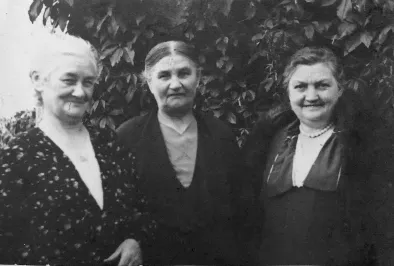![]()
PART I
PREWAR CHILDHOOD
![]()
1
IMPERIAL ANCESTORS
Ancestral traditions, even if only dimly remembered, have a powerful impact on the lives of families. While youths may try to escape from familial constraints, their choices are limited by preexisting structures over which they have no control. Ancient legacies establish patterns of belonging such as national affiliations, social settings, religious customs, and regional ties. More directly, grandparents whose lives overlap with those of their grandchildren transmit occupational preferences, material circumstances, and codes of behavior via a mixture of discipline and love. Most immediately parents shape their children’s life chances and value choices through their examples and personalities, professional successes and failures. It is this invisible baggage, which pastor Erich Helmer likened to “a backpack, in which we have put everything that life has brought us,” that forms subsequent lives, even if most people are hardly aware of it.1
Forebears largely shaped the life chances of post–World War I German children by their actions during “the Kaiser’s era,” also known in retrospect as “the good old days.”2 Seen from the perspective of subsequent upheavals, these “were pleasant, peaceful years.” Berlin salesgirl Edith Schöffski recalled that in the countryside “people were contented and often happier than today.” Life seemed well ordered and predictable. “Unless something absolutely had to be done in the fields, only essential tasks were completed on Sunday. In the afternoon, women sat on the bench in front of the house with their neighbors or passersby, talking or musing” about their affairs. “That was the reward for the hard work during the week.”3 In the more affluent cities, bourgeois families enjoyed a noon dinner with a roast, promenaded in their finery in a nearby park, and refreshed themselves with coffee and cake. This was a stable world in which everything seemed to have its place.
While living conditions were generally improving, the autobiographies also show that the lower classes experienced the prewar decades of the Second Reich as a “period of poverty and need.” Although many businessmen were pleased about rising receipts that allowed them to prosper and professionals enjoyed the social esteem of an academic title, small shopkeepers and artisans just scraped by.4 According to Edith Schöffski, rural life remained hard for maids and farmhands: “The meager food sufficed just for living and working. [Laborers] had to toil twelve to fourteen hours a day. There was no free time.”5 In the cities, proletarian families lived in damp one-room tenements rife with disease, and their children were regularly beaten in school to enforce discipline. Engineer Karl Härtel recalled that his father, a worker in a power plant, “incessantly tossed coal with an oversized shovel into the insatiable mouth of a boiler for over fifty hours a week.”6 The shining image of growing imperial power and prosperity had a darker underside characterized by hard labor and a basic lack of rights.
The character of Imperial Germany has therefore sparked endless arguments among historians about whether it was basically oppressive or benign. West German apologists initially tried to defend its positive character, while East German Marxists attacked Prussia as repressive, justifying the demolition of the royal castles in Potsdam and Berlin. Inspired by the generational revolt of the 1960s, critical Federal Republic of Germany (FRG, West Germany) historians such as Hans-Ulrich Wehler developed the theory of a “special path,” charging that Wilhelmine Germany’s partial modernization deviated from Western notions of democracy, following a policy of “social imperialism.” But moderate scholars pointed to advances in the rule of law and progress in science and culture, while their British colleagues emphasized that the middle class had more power than it was given credit for.7 This Sonderweg debate has remained somewhat inconclusive, for there is much evidence to support both contending views.
The colorful reminiscences of the children born during the 1920s provide an alternate perspective on German experiences in the Second Reich, because they report on how it was remembered by ordinary people. Shaped by accounts of their grandparents, the image of the Empire created a baseline of expectations according to which later experiences were judged. Forester Horst Andrée recalled that “at family get-togethers talk always turned to our ancestors: who they were, where they came from, where they lived and what occupations they had.” While written records such as “deeds, old letters, or photos” and objects of material culture helped establish a family memory to explain who they were, “many questions remained open.” More permanent than oral stories, autobiographies are therefore a conscious attempt to commit traditions to paper so as to “provide better insights than those that we had” to one’s own offspring.8 Such personal narratives convey highly ambivalent legacies of the Empire to the children born after World War I.
ANCESTRAL TRADITIONS
The impact of prior generations on subsequent lives is difficult to determine, because most autobiographical narratives are reticent about their distant ancestors. Although the telling of family stories was an essential part of entertainment in the past, references to forebears tend to be vague and sparse.9 Many autobiographies are full of old photographs of forefathers, carefully posed portraits like that of the grandfather and father of Ruth Weigelt that capture self-important-looking men in uniform (image 2). Other snapshots commemorate significant life events such as weddings, births, or confirmations, but later descendants are often unsure about who the people in the pictures actually are unless the names and occasions are marked on the back. A few writers actually turned to genealogical research in order to construct elaborate family trees, which often contain nothing more than a name, a date, and a place.10 Hence, references to an earlier family background tend to be shrouded in mystery, allowing later descendants a wide field for the play of imagination.
2. Imperial grandfather and father. Source: Winfried Weigelt.
The harmless question of ancestry only turned into a dangerous problem when the Nazis demanded proof of Aryan descent for marriage and public employment. The 1933 law for the restoration of the professional civil service defined as non-Aryan anyone “who is descended from non-Aryan, especially Jewish parents or grandparents.” Since it was impossible to prove race with biological measurements, this anti-Semitic provision triggered frantic searches in civil registers and “church books” for documentary evidence. Due to conversion, intermarriage, and secularization, the blurring of religious boundaries had created many individuals of mixed ancestry. Because the discovery of a Jewish grandmother might imperil their lives, many affected families, such as the Helmers, used expedients such as the discovery of a relation to a prominent Nazi to remove such presumed stains from their background. In the racist world of the Third Reich, proving Aryan descent became a matter of survival.11
Without such prompting, it took unusual pride in a particular lineage for families to remember earlier generations of ancestry. Working-class memoirs rarely recall their grandparents’ names, for the struggle for existence prevented the keeping of records. But middle-class families with uncommon backgrounds, such as descent from Huguenot refugees—like that of forester Andrée from Pomerania—were more likely to preserve that memory.12 Members of religious minorities struggling for social acceptance, such as the Gompertz family of Jewish merchants in the Ruhr Basin, cultivated a sense of ancestry, especially if their present success contrasted favorably with their humble beginnings.13 Similarly, authors such as Benno Schöffski who were displaced made an effort to transmit a nostalgic picture of a lost homeland to their offspring.14 Finally, representatives of the elite like the Scholz-Eule clan, prior owners of an estate in Silesia, maintained memory as a basis for potential claims for restitution.15
One basic tradition that these various ancestors bequeathed to their descendants was their cultural identity as Germans. Except for Joachim Fest’s quasi-aristocratic grandparents, who conversed in French, and Gerhardt Thamm’s Silesian forbears, who also spoke Polish, the men and women in this study all shared the same written language. Moreover, their offspring inherited a series of social customs such as Sunday conviviality in beer-gardens or gathering around candlelit Christmas trees, which distinguished them from their western and eastern neighbors. The package also included the later-maligned “secondary virtues” of hard work, discipline, punctuality, and respect for authority that rendered the stamp “made in Germany” a commercial success. Finally, the legacy included socialization into a high culture of literary giants such as Goethe and Schiller, philosophers such as Kant and Hegel, and composers such as Bach and Beethoven.16 These shared customs and cultural referents forged a sense of community, even if their specific interpretation remained highly contested.
Another legacy was a national liberalism that advocated constitutional government and the unification of the fragmented territories into a nation-state. Most of the great-grandparents who were born during the 1830s were disappointed in the failure of the 1848 revolution and the slow process of gaining political rights, which made some emigrate to the United States. But the unexpected success of the drive for unification made the Prussian king into German emperor Wilhelm I and Chancellor Otto von Bismarck into a folk hero who was celebrated in popular culture. Moreover, the battlefield triumphs in three successive wars against Denmark (1864), Austria (1866), and France (1870–1871) also endowed the military with enormous prestige. The building of a common state required a fundamental redirection of loyalties from the local Heimat toward a larger national sense of belonging. Bismarck’s subsequent struggle with the Catholics, the promulgation of anti-Socialist laws, and the rise of postemancipation anti-Semitism revealed that the Protestant Prussian attempt to reshape Germany in its own image remained contested and incomplete.17
Yet another bequest was the memory of the industrial transformation of the environment in the Ruhr, Silesia, and the Saar, which turned a pastoral land of villages into booming coal and steel country. While industry arrived, largely as an import from Britain and Belgium, its support through technical innovation and government sponsorship created rapid progress, catching up with and surpassing the earlier leaders on the eve of the First World War. The introduction of fertilizer and machines into agriculture freed many farm workers, who then streamed into the industrial cities, turning sleepy country towns in the Ruhr and Silesia into bustling cities. In order to improve housing conditions in the national capital, Berlin, Joachim Fest’s maternal grandfather helped develop an entire new suburb in Karlshorst. Though factory labor was strenuous and living conditions remained deplorable, this urbanization eventually changed living habits and literacy standards, allowing even some of the proletariat to claim political participation.18
A final inheritance was a sense of social mobility that lifted enterprising individuals and entire regions to higher levels of prosperity. For instance, one of Hans Queiser’s grandfathers was a beltmaker in the small town of Idar-Oberstein in the Moselle area. Entering an apprenticeship at a local bank, the son ascended to a position on the board of the institute, lived in a company apartment, and had so much “success in his occupation” that he was able to marry and to employ several servants. The other grandfather, from Cottbus in Brandenburg, had started as a boiler stoker but, with hard work, advanced to become director of a worsted yarn–spinning mill. Similarly, Benno Schöffski’s father began as a simple postman, having to carry the mails through all sorts of weather in East Prussia, but ended up as a superior clerk in the regional postal center at Königsberg. Repeated in countless Wilhelmine families, this individual advancement created a collective sense of pride that fueled an optimistic expectation of further progress in the future.19
The deep memory transmitted from ancestors through oral stories was therefore somewhat paradoxical. On the one hand, there was much nostalgia for a picturesque past of medieval “home towns” like Rothenburg in Bavaria, whose thick-walled castles, gothic churches, half-timbered houses, and cobblestoned streets seemed to have remained unchanged throughout the centuries.20 On the other hand, there was a growing sense of German identity beyond the local loyalty to one’s dynasty, a liberating feeling of a larger scope for business and scholarship that would enable the nation to compete with already-established states such as France and Britain. At the same time, the dynamism of the industrial transformation, symbolized by the coming of the railroad and the ocean liner, suggested the acceleration of changes that would destroy the accustomed hierarchy and security.21 It was this tension between local origin and national belonging, as well as agrarian nostalgia and industrial urbanism, that would challenge a future generation.
GRANDPARENTS’ INFLUENCE
In contrast to distant ancestors, grandparents were a living memory; their partly strict, partly loving authority overshadowed many a childhood. Due to the generational difference in age, they commanded respect for their life experience and achievement, whether in managing a farm, running a store, or pursuing a profession. Though a few continued to work in spite of declining strength, most grandparents were retired, now having time for hobbies such as cultivating a garden, keeping bees, or just smoking a pipe. For Christmas, Edith Schöffski’s grandfather carved “a pretty doll house with furniture, oven and outhouse,” while her grandmother “sewed linen and everything else for the tiny beds and of course also baked spice cake [Lebkuchen].”22 Another grandfather told funny stories about his own exploits as a youth and led the children in silly games. While their parents resented the harsh discipline these same men and women had inflicted on them, the grandchildren usually remembered Opa or Oma fondly once a disease such as tuberculosis took them away.
3. Wilhelmine grandmothers. Source: Benno Schöffski, “Meine Familiengeschichte.”
In their eyes, the grandparents’ lives were strictly divided along gendered lines, with grandfather the head and grandmother the soul of the family. The former ruled his flock with paternalistic authority, making all the important decisions, controlling finances, and meting out strict discipline. Grandfather was responsible for his family’s material well-being, putting the daily bread on the table and providing a bit of ease beyond. In the countryside, it was the farmer who controlled the servants and the animals, deciding when and where to plow. In the cities, the master lorded over his business, keeping apprentices and clerks in line. The family head was also in charge of relations with the outside world, safeguard...


